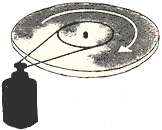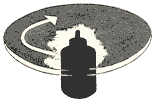BELT DRIVE VS DIRECT DRIVE: A QUESTION OF
TORQUE
How a record player works is quite simple. A motor is somehow connected
to a solid disc so that the disc is rotated at a constant speed. On top of the
rotating disc (platter), The record is placed on top, with a slip mat in between.
The slip mat can serve two functions. In the past to hold the record in place
so that it would not rotate independently of the platter. Now, however, the
slip mat serves a much different function. Instead of holding the record in
place, the slip mat is now used to reduce the friction between the spinning
platter and the record. This way a DJ can scratch (manually move the record,
usually at high speeds) the record while the platter continues to spin underneath.
Once the record is rotating, a stylus glides along the grooves and picks up
the vibrations, these are then converted into audible sound.
There are many different models of turntables still being manufactured.
Of those being sold, it is possible to divide them into two separate categories
based upon their motor system. Virtually all record players being manufactured
today have either belt drive or direct drive motors. For the reasons discussed
below, direct drives are accepted as the industry standard for professional
DJs and turntabilists.
Belt Drive
 -
-
There are two advantages to the belt drive design. The motor in a belt driven
turntable is set away from the platter by means of a continuous belt loop. This
minimizes vibration to the platter and thus needle skipping. Also, belt drive
models tend to be much cheaper than their direct drive counter parts.
These advantages, however, do not balance the many short falls of the belt
drive design.
Over time the belt can become loose and begin to slip, causing variations in
the platter speed. Belt drive turntables have much lower torque. This leads
record to be much more susceptible to outside forces. The contact between the
stylus and record causes a frictional force in the form of torque, as the stylus
angular path gets closer to the center of rotation the force decreases. Thus,
at the start of a record, the stylus contact could actually decrease the speed
of the record by up to 3%, while at the end of the recording, the distance from
the center is much less. The torque is much smaller and will have little or
no noticeable affect on the speed of the record.
Direct Drive

The sole disadvantage to direct drive turntables is the vibration from the motor,
which is located directly under the center of the platter. However, in recent
years, shock-absorbing (less dense) material, placed between the motor and platter,
has been used to cut back on vibrations. Again the deciding factor is torque.
Since the motor is directly connected to the platter through a system of gears,
the torque is usually much higher than in the belt drive models. Higher torque
means the platter speed is less susceptible to outside forces (stylus, hand).
A higher torque also means that the platter will accelerate faster, therefore,
there will be less distortion heard when the record starts to play.
Home The
Turntable The Stylus The
Vinyl Dr. Physics Bibliography
 -
-